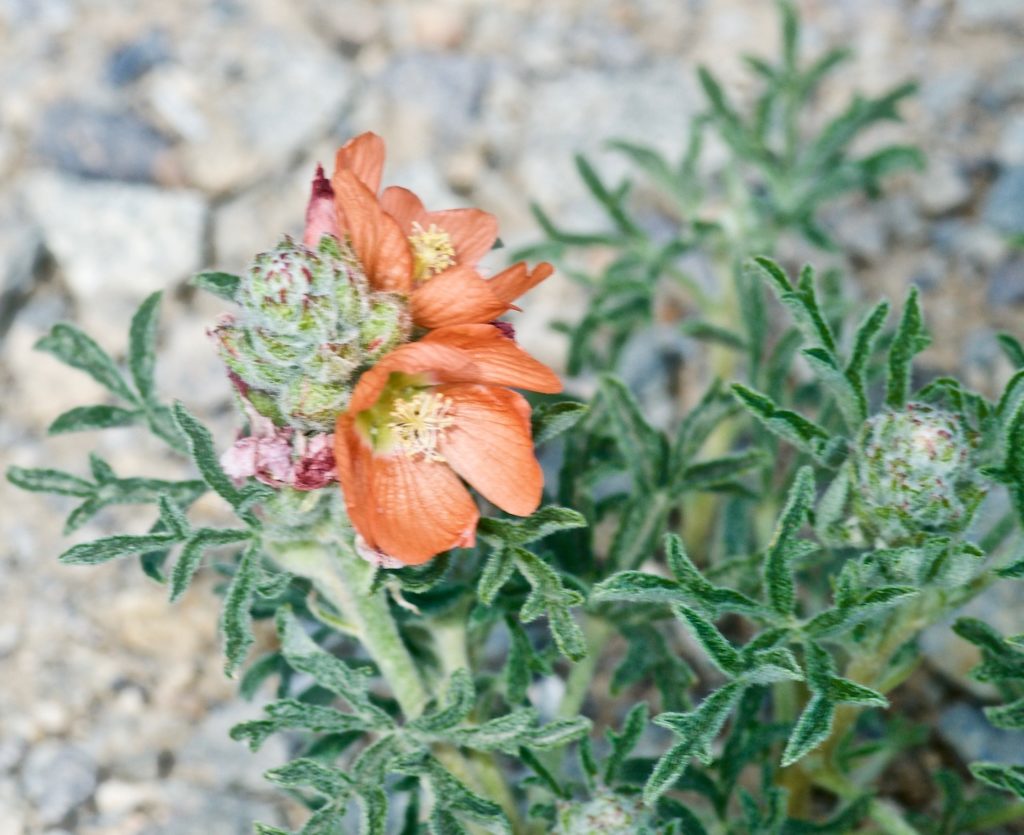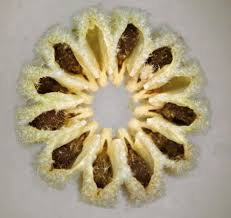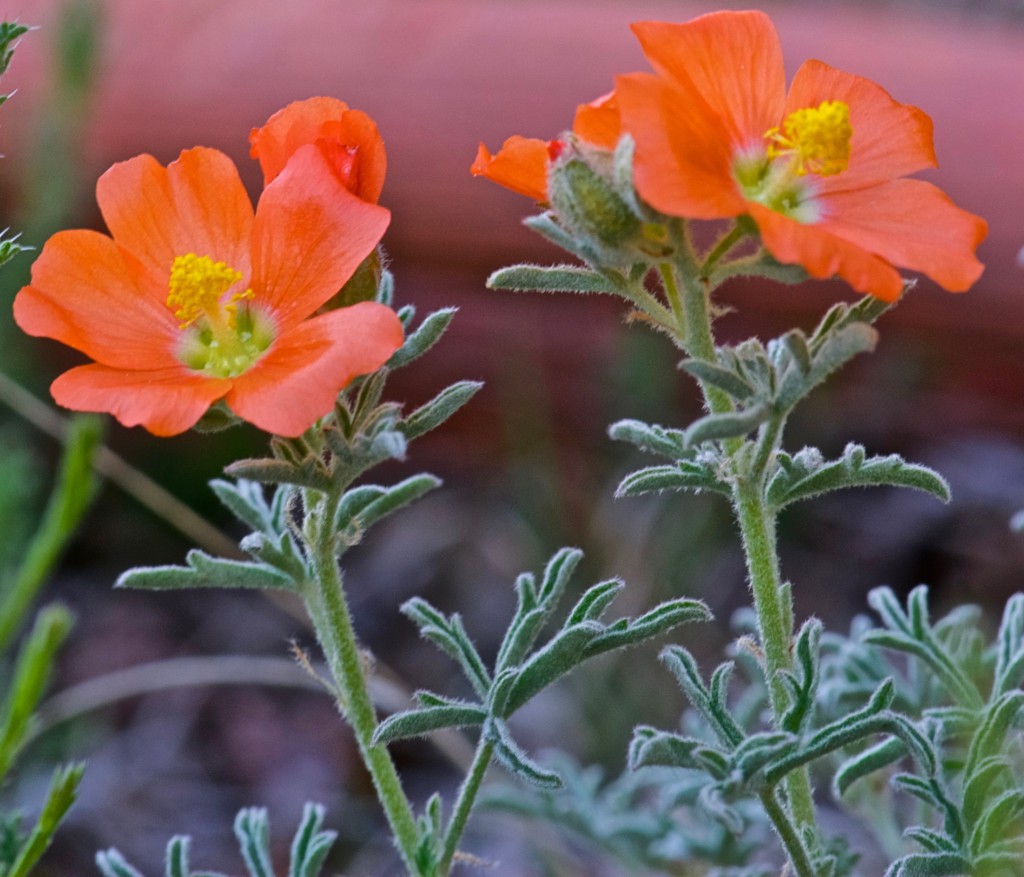Scientific name: Sphaeralcea species
Common name: globemallow
Family: Malvaceae -mal-VAY-see-eee. Common name: mallow
Genus: Sphaeralcea – sfeer-AL-see-uh. Common name: globemallow
Species featured:
- Sphaeralcea angustifolia – an-gus-tee-FOH-lee-uh. Common name: narrowleaf globemallow
- Sphaeralcea coccinea – kok-SIN-ee-uh. Common name: scarlet globemallow
- Sphaeralcea fendleri – FEND-ler-eye. Common name: Fendler’s globemallow
- Sphaeralcea ambigua ‘Louis Hamilton’ – am-bog-yoo-uh. Common name: ‘Louis Hamilton’ globemallow
- Sphaeralcea munroana – mun-roh-AH-nuh. Common name: Munro’s globemallow
Text by: Janice Tucker.
Photos by: American Southwest, Ken Bower, James Cane (USDA), Norman G. Flagg (Lady Bird Johnson Wildflower Center), and Janice Tucker
Globemallows (Sphaeralcea) light up the landscape from spring through early autumn with vibrant flowers framing bright centers. These cheerful, orange-red, perennial wildflowers are scattered among open fields, arroyos and woodlands. They wave at passers-by from along roadsides where they form colorful borders. And not only do the globemallows thrive as wildflowers, several species adapt well to spiffing up flowerbeds maintained by indulgent gardeners.
Of the 40-60 globemallows, the the three most prevalent wildflower species in the Santa Fe and the surrounding area are the narrowleaf (S. angustifolia), scarlet (S. coccinea) and to a lesser extent, the Fendler’s (S. fendleri). These native, perennial mini-mallows of the Malvaceae (mallow) family revel in the rough and tumble environment where they grow wild, uninhibited by dry climate, iffy soil, high winds and dramatic swings in temperature. Despite the varying altitude ranges given for these three species, their mere presence is evidence that they all thrive in the 7,000+ feet elevation of Santa Fe and nearby areas. The hairy coating and the gelatinous consistency of the stems and leaves trap moisture to protect the plants from dehydration. This is a vital characteristic that allows the globemallows to thrive in their native regions of the southwestern United States as well as parts of Canada and Mexico.
Despite the species’ visual differences in growth habit and leaf shape, the globemallows’ kinship becomes apparent when they burst into bloom with each species producing practically identical flowers. Lovely racemes of 5-petaled flowers encircle a soft-white center that surrounds neon-green, integrated styles from which several fused, yellow (sometimes whitish) stamens extend. Globemallows are often cupped inward but the Fendler’s and sometimes the scarlet globemallows stretch their petals wide in orange-tinted rays. Most globemallows emerge as red buds that turn an orange-red as they open. However, flowers in the mallow family delight in keeping us from becoming too complacent. That is probably why Mother Nature threw a maverick blue-flowered variety of the Fendler’s globemallow into the mix.

S. coccinea flowering around bud. Photo by Janice Tucker.
As shown in the accompanying photograph, racemes of orange flowers open up around a globe-shaped bud. Hence, the scientific and common names for the genus of the species. Sphaeralcea is a combined word from the Greek, spharia for “globe or orb” and alcea for “mallow”. “Globemallow” is the simple English translation of the scientific name. The scarlet globemallow’s flowers produce colorful bouquets as they encircle the bud located at the terminal end of the branches. The blooms of the narrowleaf and Fendler’s globemallows are cradled at the leaf axils, resulting in spiral floral displays as they wrap around the stem. As the flowers fade away, they reveal a seed capsule resembling a multiple spoked wheel with a seed nestled in each spoke. The seed form is unique to each species, which is one way to make an accurate identification if you have the knowledge and patience to do so.

Cross section of S. muronana seed capsule. Courtesy James Cane, ARS, USDA
Globemallows are true to the mallow family’s seemingly impish trait for mixing up leaf shapes. The species, angustifolia, is from the Latin for “narrow leaf”, which is descriptive of the long, slender leaves of the narrowleaf globemallow. They have serrated margins with two lobes near the base, The Fendler’s globemallow (S. fendleri), is named in honor of the Prussian-born American botanist, August Fendler (1813-1883). Its leaves are long, with gently scalloped margins. They have two lobes near the stem and two below the tip. The species, coccinea, is from the Latin, meaning “scarlet”. Coccinea refers to the orange-red flowers. (“Scarlet” must be a color left to individual interpretation!) The lacy appearance of the scarlet globemallow is due to leaves that are deeply cut into three divisions, which are then divided into more divisions, rendering more of a palmate shape. Botanists tell us that the globemallow leaf shapes can be variable even within one species. Personal experience in trying to identify globemallows in the field only by leaf shape supports this theory. Could that leaf be lobed near the tip or is it just a slight or not-so-slight widening? Lobes near the tip means it is probably Fendler’s globemallow but if it is just a slight widening, it could be the narrowleaf globemallow. No one ever accused botany of being without its conundrums.
Before trekking off into the fields, hills and valleys in pursuit of wild globemallows to transplant in the home garden, it might be easier to purchase seeds or plants commercially. And don’t shy away from seeds since they reportedly germinate quickly when planted in fall or spring. Just plant, add water and watch them sprout. Digging up wild globemallows could end up being quite the chore, especially if tackling the scarlet globemallow. It may be small above ground but its lateral roots extend about three feet below ground, and three feet is a long way when having to dig. A word of caution about globemallows in general and the scarlet globemallow in particular: Most wild globemallows tend to be a bit grabby with garden space and it is possible they will try to take over a flower bed. The scarlet globemallow spreads by rhizomes, which means it can be quite aggressive. If you plant this species, be prepared to either pull up suckers or stand back and give it space to spread. Globemallows like full sun, soil that drains well and very little supplemental water after they are established, Handling the hairy leaves and stems can cause skin irritation, so be certain to wear gloves when working with any globemallow. Deadheading flowers will not encourage new blooms but cutting back withering branches and stems will keep the plant looking its Sunday best in the garden. Gardeners who compete with deer and rabbits will rejoice that neither critter cares to nosh on globemallows. Native bees and other insects are the primary pollinators.
For those who prefer tried and true garden plants, the melon-red flowered ‘Louis Hamilton’ globemallow (Sphaeralcea ambigua ‘Louis Hamilton’) and/or Munro’s globemallow (Sphaeralcea munroana) are two varieties cultivated for home and public gardens. The species, ambigua, is from the Latin, meaning “uncertain or doubtful”. (One wonders why anything defined as “doubtful” is even a species name!) The species, munroana is in honor of British botanist, William Munro (1818-1880). These cultivated globemallows are in the Botanical Garden at Museum Hill located in Santa Fe, New Mexico. Both varieties grow alongside other native plants in the Ojos y Manos section in the Sunrise Discovery Garden (Goede). Also look for the ‘Louis Hamilton’ adjacent to the Procession Walk, east bed and Munro’s next to the Sunrise Discovery Area Walk (Gabriel). Both varieties are available commercially.
People depended on nature for medicines and other personal products before the corner drug store or national pharmacy chains existed. Our ancestors discovered that globemallows relieved and/or cured many ailments. Today’s herbalists no doubt still put some of these remedies to use. The gelatinous leaves and stems provide remedies to soothe burns and other skin problems. But don’t forget to wear gloves when handling those hairy stems and leaf bristles. They can cause skin problems rather than relieve them. A tea made with the leaves helps to soothe a sore throat or an upset stomach. The list goes on with claims of improving a suppressed immune system as well as aiding in the treatment for lung, prostate, and urinary tract problems. Broken bones, insect bites or a headache? Mix some flour and salt with the roots to make a poultice to spread over the applicable area. Etc. etc. etc. A strong tea makes a nice hair rinse. Or that tea will curl the hair if not washed out. Perhaps it would be best to stay home when first trying the hair curling option just in case it ends up creating a bad hair day. And yes, globemallows are edible but not really very tasty.

S. coccinea flower wide open by Janice Tucker.
One would never guess that the globemallows, with their pretty orange-red flowers, are among the hardiest of the hardy wildflowers that thrive in New Mexico. They scoff at the challenging growing conditions nature throws at them. If you’re looking for inspiration to face life’s challenges, look no further than a nearby field or along the roadside to see the unflappable globemallows seemingly blooming without a care in the world.
Many thanks to Helen Woody for proofreading this article.
Sources consulted and/or cited:
Allred, Kelly W. Flora Neomexicana II: Glossarium Nominum- A Lexicon of New Mexico Plant Names. Las Cruces, New Mexico. Range Science Herbarium Department of Animal and Range Sciences New Mexico State University, 2009. Print
Bower, Ken. Ethnobotanicals in the Santa Fe Botanical Garden. Web. 24 Nov. 2018. Text Retrieved from: http://www.eldoradowindyfarm.com/SFBG-ethnobotanicals.html . Photograph retrieved from: http://www.eldoradowindyfarm.com/SFBG-ethnoglobemallow.html
Curtin, Leonora S.M. Healing Herbs of the Upper Rio Grande Traditional Medicine of the Southwest. Revised and Edited by Michael Moore. Santa Fe, New Mexico: Western Edge Press, Second Edition 1997. Print
Littlefield, Larry J. and Burns, Pearl M. Wildflowers of the Northern and Central Mountains of New Mexico, Sangre de Cristo, Jemez, Sandia and Manzano. Albuquerque, New Mexico: University of New Mexico Press, 2015. Print.
Moore, Michael, Medicinal Plants of the Mountain West. Santa Fe, New Mexico: Museum of New Mexico Press, Revised and Expanded Edition, 2001. Print.
National Audubon Society Field Guide to Wildflowers Western Region. New York City: Alfred A. Knopf, Inc, Revised Edition 2001. Print.
Schneider, Al. “Four Sphaeralceas” (Globe Mallows)”. Southwest Colorado Wildflowers. Web. 04 May 2005. 03 Nov 2018. Retrieved from: https://www.swcoloradowildflowers.com/Pink%20Enlarged%20Photo%20Pages/sphaeralcea.htm .
“Sphaeralcea fendleri, Fendler’s globemallow”, Sphaeralcea munroana, Munro’s globemallow”. Text and Photos. The American Southwest, www.americansouthwest.net. Web. 24 Nov. 2018. Retrieved from:
http://www.americansouthwest.net/plants/wildflowers/sphaeralcea-fendleri.html .
http://www.americansouthwest.net/plants/wildflowers/sphaeralcea-munroana.html .
“Sphaeralcea fenderli”. Photograph by Norman G. Flagg. Native Plant Information Network. Lady Bird Johnson Wildflower Center. 08 Sept 2017. Web. Accessed 24 Nov. 2018. Retrieved from:
https://www.wildflower.org/gallery/result.php?id_image=923 .
“Sphaeralcea Ambigua Louis Hamilton Globe Mallow”. Mountain States Wholesale Nursery. 2003.Web. 03 Nov. 2019. Retrieved from:
http://www.mswn.com/media/info_sheets/sphaeralcea_ambigua_louis_hamilton.pdf .
“Sphaeralcea ambigua ‘Louis Hamilton’ ”. “Sphaeralcea angustifolia”. “Sphaeralcea coccinea”, “Sphaeralcea fendleri”, and Sphaeralcea munroana”. Garden Explorer. Santa Fe Botanical Garden. 29 Oct. 2018. Web. 03 Nov. 2019. Retrieved from:
https://santafebotanicalgarden.gardenexplorer.org/taxon-770.aspx .
https://santafebotanicalgarden.gardenexplorer.org/taxon-664.aspx .
https://santafebotanicalgarden.gardenexplorer.org/taxon-665.aspx .
https://santafebotanicalgarden.gardenexplorer.org/taxon-667.aspx .
https://santafebotanicalgarden.gardenexplorer.org/taxon-669.aspx .
“Sphaeralcea”. “Sphaeralcea ambigua (desert globemallow)”. “Sphaeralcea angustifolia (narrowleaf globemallow”. “Sphaeralcea coccinea (scarlet globemallow)”. “Sphaeralcea fenderli (Fendler’s globemallow)”. SEINet Portal Network, 2018. http//:swbiodiversity.org/seinet/index.php . Accessed on November 04.
Retrieved from:
http://swbiodiversity.org/seinet/taxa/index.php?taxon=Sphaeralcea&formsubmit=Search+Terms .
http://swbiodiversity.org/seinet/taxa/index.php?taxon=Sphaeralcea+ambigua&formsubmit=Search+Terms .
http://swbiodiversity.org/seinet/taxa/index.php?taxon=Sphaeralcea+coccinea&formsubmit=Search+Terms .
http://swbiodiversity.org/seinet/taxa/index.php?taxon=Sphaeralcea+fendleri&formsubmit=Search+Terms .
“Sphaeralcea ambigua ‘Louis Hamilton’ “. Theodore Payne Foundation for Wild Flowers and Native Plants. California Native Plant Database. 12 Oct. 2009. Web. 03 Nov. 2019. Retrieved from:
http://www.theodorepayne.org/mediawiki/index.php?title=Sphaeralcea_ambigua_%27Louis_Hamilton%27 .
“Sphaeralcea ambigua A. Gray (desert globemallow)”. USDA, NRCS. 09 2016. The PLANTS Database (http://plants.usda.gov , 04 Nov. 2018.) National Plant Data Team, Greensboro, NC 27401-4901 USA.
“Munro’s Globemallow Sphaeralcea munroana (Douglas) Spach”. USDA, NRCS. 09 2016. The PLANTS Database (http://plants.usda.gov , 24 Nov. 2018.) National Plant Data Team, Greensboro, NC 27401-4901 USA.
Whitson, Tom D., Burrill, Larry C., Dewey, Steven A., Cudney, David W., Nelson, B. E., Lee, Richard D., Parker, Robert. Weeds of the West. Jackson, Wyoming: Western Society of Weed Science, The Western United States Land Grant Universities Cooperative Extension Services and The University of Wyoming, 1991. Print.


